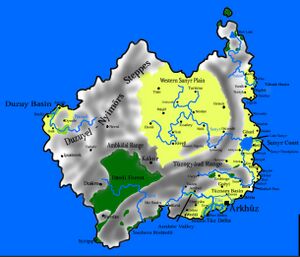Etzeá
Jump to navigation
Jump to search
This article is a construction site. This project is currently undergoing significant construction and/or revamp. By all means, take a look around, thank you. |
| Etzeá | |
|---|---|
| i etzé | |
| Pronunciation | [ɨ.ɛd͡zeə̯] |
| Created by | Jukethatbox |
| Date | 2023 |
| Native to | Etzeán Island |
Yeldhic
| |
Dialect |
|
| Official status | |
Recognised minority language in | Moshurian Empire |
 The homeland of 77.2% of Etzeá speakers, Etzeán Island. | |
Etzeá is the secondary language spoken on the island of Etzeán within the Moshurian Empire.
It is linguistically interesting because, philologically speaking, it is the closest to Proto-Yeldhic in the Yeldhic language family.
